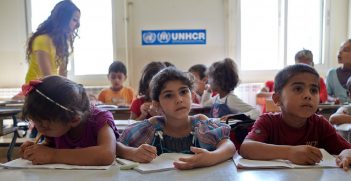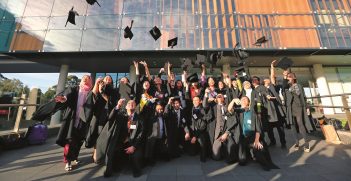Bringing Australian Foreign Policy Alive Through Teaching And Assessment Practice

In educating our students on international relations and foreign policy, we ought to expand beyond conventional wisdom and equip them with skills to deal with modern issues. Such issues include navigating “fake news,” re-thinking traditional assessment tasks, and dealing with information overload.
Every July I walk into a lecture theatre, tasked again with teaching hundreds of fresh-faced, first-year undergraduate students something—anything—about Australia’s international relations. International relations, to the first-year student, can present as an enormous and daunting set of ideas. Students frequently report that they feel alienated from the subject matter (how, they ask, can they ever know enough about the myriad issues “out there” to talk sensibly about world politics?) and that they find the teaching material too abstract to be of any use to them in their future professional lives (what good, they wonder, will an understanding of the anarchical nature of world politics be to them during an interview with the international affairs section of a future employer?).
In this short piece I want to make the case that we can help students overcome some of these feelings of alienation by adapting our teaching and assessment practices to encourage active student reflection on what it means to put Australia at the centre of their study of international relations.
Of course, we must teach students something concrete about the traditions of Australian foreign policy, the dynamics of foreign policymaking, and the domestic and external factors influencing the trajectory of foreign policy, including leadership, events, the bureaucracy, and Australia’s bilateral and multilateral relationships. But while we want to equip our students with historical and empirical knowledge, we can make the degree more than this and provide a conceptually experiential opportunity for students that asks them to actively reflect on what it means to be located in an Australian classroom, looking out on the world. Put otherwise, students should be asked to actively consider the question of what it might mean to have an “Australian” perspective on international relations.
Bringing world events into the classroom
If we are to help students develop opinions and perspectives on world politics, and understand at the same time what it means to hold these opinions and perspectives in the Australian context, we need to bring the world to the classroom. This can help bridge the gap between theory and practice, and assuage the fears some students have of the former, that it is too far removed from the real world. This is of course not a radical or controversial move; international relations does not need to be abstract. To the contrary, it is in fact a constantly evolving, highly relevant discipline, whose own debates around ideas, actors, structures, and political and ethical dilemmas are being played out in real time in the world around us. The challenge, of course, is to bridge the gap between the content we teach and its applicability to world events. Active learning exercises, like role plays or simulations, are one way to do this. But these sorts of assessments, valuable as they are, are best executed in smaller courses and can be difficult to replicate in first-year courses with enrolments in the hundreds. A more manageable, but still dynamic, approach (which, ideally, will set students up with easily transferable skills and habits) is to incorporate engagement with world news coverage into the weekly course content.
A common lament: “If only our students would pay more attention to the world they are studying!” Surely, we ask each other, over coffee and at the sidelines of conferences, it is not too much to expect that a student enrolled in an international relations degree at a university might read the news now and then?
Yes, it is easy to be scornful of how little attention undergraduates seem to pay to the world around them. And yet it is hard to overstate the significant impediments facing our students as they try to interact meaningfully with the international news media. We need to identify and face these head on. As I see it, there are three major challenges that we must deal with as teachers of international relations, and especially in the Australian foreign policy classroom.
First, students are faced with a significant case of information overload. Keeping abreast of major developments is not (or at least, is no longer) simply a matter of opening your favourite broadsheet to the international affairs section. Instead, students have to sift through a mountain of internet-based news to find quality, relevant, and reliable sources. We need to help our students develop specific skills to do this.
Second, our students are faced with the overwhelming message that news is unreliable, that their social media platforms are feeding them fake news, and that nothing they read can be trusted. Again, if we do not teach our students how to become confident and discerning in their approach to following and understanding world events, their healthy scepticism of the media landscape quickly turns into disillusionment, and they tune out. I hear time and time again, from my students, that this is what is happening.
Finally, and this is a problem that is certainly not unique to a particular demographic or cohort, is the question of innate bias in the way we curate our newsfeeds. We must encourage students to find reliable and clever people and news outlets, which take ideological or political positions that do not align with their own, and engage with them thoughtfully.
What then are some practical ways in which we can help our students overcome these very real hurdles? I propose that authentic assessment can be an effective response to these problems. In my first-year international relations/foreign policy class, in addition to a traditional research essay, I have reconfigured two separate pieces of assessment—classroom activities and final exams—in order to encourage a self-reflective and engaged approach to the study of Australian foreign policy.
More than participation
First, in lieu of simply marking attendance, participation can encourage the learning of specific skills, strategies and habits that students of Australian foreign policy or international relations can adopt to help them develop smart, targeted and balanced news habits. In the tutorial environment, we should be direct about this and start by asking students how they currently access the news and crowd source new ideas. In doing this, we can also acknowledge the challenges by sharing, openly and honestly, the difficulties we ourselves face, and our own approach to curating news habits. This helps students understand that, like essay writing and exams, “keeping up with the news” is a skill that must be learned. We can then introduce students to a wide range of reliable sources and platforms, so that they can create new habits for themselves. These should include mainstream news outlets from across the ideological spectrum, radio programs and podcasts, apps and websites. Encourage students to do things like change their home page URLs, set search alerts, or put a reminder in their phone every day to spend twenty minutes perusing their chosen outlets. For the students who take this exhortation seriously, the habits they develop in the first year of their university life will set them up as more engaged and knowledgeable members of their communities and will help them to interact with international relations in a deeper and more meaningful way.
We can, and should, assess students on their efforts to do this. Each week, in the small-class tutorial setting, prioritise it by setting aside ten minutes for a “news wrap”, and incentivise this with dedicating a portion of the student’s final grade to the quality of their participation in this weekly discussion. Students are tasked with coming to class armed with at least one story from the week’s news. Not just any story will do. The story must have an Australian angle and should relate to the topics, ideas, or themes being discussed that week. It should, in this way, complement that week’s scholarly reading and lectures. In the early weeks, a Powerpoint slide with headlines can help prompt discussion; (see Figure 1).
Figure 1. Example of a Powerpoint slide designed to prompt in-class discussion about Australian foreign policy-related news.
More than an exam
The traditional exam has a lot going for it. It helps cut down on cheating. In a high enrolment subject, it allows a large number of responses to be marked easily and quickly. However, in a subject that encourages students to interact with multiple sources in a discerning and intelligent manner, this kind of assessment makes little sense. As I tell my students: “I cannot imagine a future situation where you will be locked in a room without access to the internet and asked to write a detailed analysis of a piece of foreign policy.” We need to redesign this assessment to render it more authentic.
First, we can explicitly describe the rationale of assessment to students. This invites them to reflect on how they might actively articulate the skills they have to deploy in assessment as part of a toolkit their future professional selves will one day be grateful for. In my classes, I do this by making the case for a new approach to summative examinations:
I can imagine the following scenario: you are employed as some sort of advisor or analyst. Your boss comes to you one morning and says “I need a 3 page brief on how proposed policy X will affect Australia’s diplomatic relations with Indonesia, and I need it on my desk by 2 o’clock this afternoon.” You will have access to the internet, but very limited time, so your ability to do this task well will depend on how well prepared you are in terms of your knowledge of the subject area, and your ability to quickly identify reliable sources to back up or verify your claims. Your final exam is designed to recreate that potential future scenario.
Second, I turn the “problem” of information overload upside down by making tackling that overload a meaningful part of the assessment. Ease of access to the internet for students and increasingly sophisticated learning management systems allows us to develop a creative approach to exams. My approach, which is flexible enough to provide content variety and cut down on the possibility of collusion, also meets the logistical demands of running an exam. First year students sit a ninety-minute timed exam, at their own computer. The exam reveals a random selection of two questions (from a larger bank of more than thirty questions) from which students choose just one to answer. Students are granted flexibility in when and where they sit the exam—early in the morning? late at night? at home? in the library?—and are given a seven-day window to complete the timed quiz which, once started, must be finished and cannot be paused. In 800 words, and guided by a clear rubric, students are encouraged to deliver creative and insightful responses that demonstrate global reflection on course themes (ideas, actors, issues relevant to Australian foreign policy), based on reference to scholars as well as other credible analysts, commentators, and news sources. They are using both discipline-specific knowledge (theoretical and empirical), and the important new skill of identifying accurate information.
This sort of assessment, combined with a more traditional research essay during the semester and a minor assessment based on engagement with news and scholarly sources during tutorials, allows for an assessment regime which both fulfils the university’s desire to achieve promised graduate learning outcomes, and provides meaningful experiences for students.
Concluding comments: engage students where we can, when we can, however we can
Perhaps the most frequent complaint of the modern university lecturer is the paradox that the ubiquity of online resources has led to a downturn in terms of student engagement with the content we are trying to communicate with them. The best we can do is to incentivise interaction and engagement wherever we can. The Australian foreign policy classroom presents, I believe, an ideal place to do this. In this setting, students are encouraged to see themselves as having a real stake in the subject matter, as well as a valuable and valued perspective. If we can convince them of this, they are more likely to turn up and join in the conversation.
Dr Danielle Chubb is a Senior Lecturer in International Relations in the School of Humanities and Social Sciences at Deakin University and a founding member of the POLIS group in the Alfred Deakin Institute for Citizenship and Globalisation, Deakin University. She is also currently a Non-Resident Fellow at the Perth USAsia Centre.
This article is an extract from Dr Danielle Chubb’s article in the Australian Journal of International Affairs titled “Bringing Australian Foreign Policy Alive Through Teaching And Assessment Practice.” It is republished with permission.





